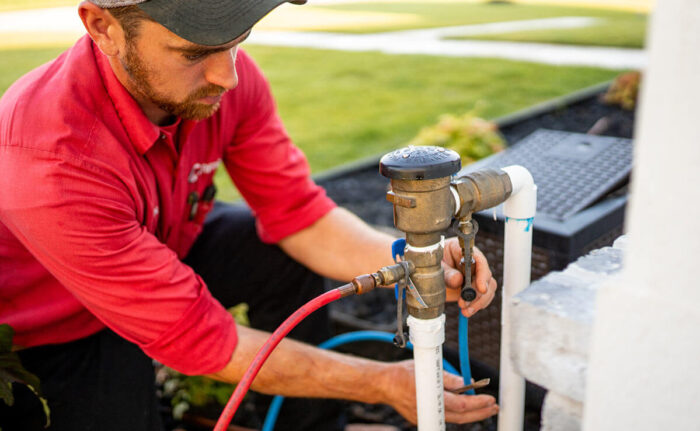Should Backflow Testing Important for Ensuring Water Quality?
Should Backflow Testing Important for Ensuring Water Quality?
Blog Article
What're your thoughts with regards to Commercial Backflow Testing?

Yes, you require to backflow test your house's supply of water to ensure that the water is without contaminants and hazardous levels of chemicals. As a result of the equipment called for and room for error, you should not attempt to perform heartburn screening on your own. We recommend that you call a specialist plumber every couple of years to examine your water.
Backflow Can Influence Both You and Your City
Since unsafe heartburn can impact the public water supply in enhancement to a single building, many cities develop heartburn guidelines. Luckily, modern-day cities have backflow devices in place that protect the water supply that originates from many homes and industrial buildings. The actual threat comes from irrigation systems, which can harm the water system with poisonous fertilizers, manure, and other chemicals.
What Creates Backflow?
A typical source of backflow is a loss of water pressure that causes the water to siphon back right into the supply of water. An instance is cleaning a paint pail using a tube. You fill up the paint bucket up with water, leaving the hose pipe in the container. After some time, there is a loss in water stress and also the tube begins to suck the water back into the water. As you can imagine, there are now chemicals from the paint that are getting in the water, potentially posturing a hazard. Unfortunately, many people are not also aware of heartburn screening, yet there are many reasons it's so essential.
Backflow Screening is Required by Regulation in Specific Cities
Depending on where you live, you could in fact be called for by regulation to backflow test your regulation. Iowa City maintains a record of all homes served by the city's water supply.
You Can Prevent Backflow
The major purpose of a backflow tool is to avoid water from moving backward into your water supply. Plumbers mount the device on the pipelines in your home to make certain that the water just moves in the proper direction.
What is Heartburn?
Simply put, backflow is when water moves upwards-- the contrary direction in the plumbing system. This is also known as "backpressure." When the water relocates this direction, it can blend with hazardous contaminants as well as present a danger.
Call a Plumber to Test for Backflow Prior To It is Far too late
A plumbing firm can rapidly test your house's water to identify if there are any type of hazardous chemical levels. And also if you do discover that your water has high levels of contaminants, a plumber can easily install a backflow prevention device.
Yes, you require to backflow examination your house's water supply to ensure that the water is complimentary of toxins and unsafe degrees of chemicals. Many cities establish backflow guidelines because hazardous backflow can influence the public water supply in addition to a single structure. A normal reason of backflow is a loss of water pressure that creates the water to siphon back into the water supply. After some time, there is a loss in water pressure and also the hose starts to suck the water back right into the water supply. The major function of a heartburn gadget is to prevent water from flowing backwards into your water supply.
WHY DOES BACKFLOW TESTING NEED TO BE DONE EVERY YEAR
What Is Backflow?
Toxic gas backing up into a building is one example of potential backflow issues, but backflow can occur in many other ways.
Backflow is generally referred to as the reversal of a liquid or gas in a plumbing system.
Most issues for the public occur with backflow resulting in contaminated drinking water. If you look up backflow issues online you’ll probably find references to “potable” water. That means drinking water.
There have been backflow issues in the past with drinking water. Chemicals, sewage and other contaminants have found their way into drinking water causing health issues for those that count on the fresh water.
What Causes Backflow?
In a residence or commercial building water generally flows one way. This normal flow is usually driven by consistent pressure in the water and waste system.
Anything that changes the normal pressure in the system can lead to backflow.
Fire hydrant use or malfunction can reverse the normal pressure in the system on a city line, but backflow can occur in a number of different ways.
Sometimes backpressure might be caused by someone using a garden hose and submerging the end of the hose in a pool of liquid. If pressure is lost the flow could reverse and contaminants could be released into the drinking water.
Anytime there is a connection between contaminants and the drinking water there is potential for a backflow issue. Sometimes these connections are not immediately obvious like the garden hose connecting to a building’s drinking water supply.
Backflow Regulations
The Environmental Protection Agency (EPA) provides guidelines and regulations for state and local governments regarding backflow. State and local governments also have their own guidelines and regulations for backflow prevention.
Arizona has its own backflow regulations.
Due to issues with backflow in the past, regulations require backflow preventer devices to be used in nearly all residential and commercial buildings.
A backflow preventer is a device that prevents backflow as cross-connection points where potential backflow issues may occur.
While backflow is not a common occurrence, preventers are in place to make sure there is no contamination should something malfunction or go wrong with a building’s water supply.

I found that piece about Backflow Assembly Testing while looking around the search engines. Sharing is caring. Helping people is fun. We take joy in reading our article about Backflow Prevention.
Further Details
Report this page